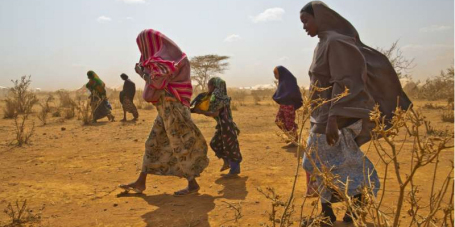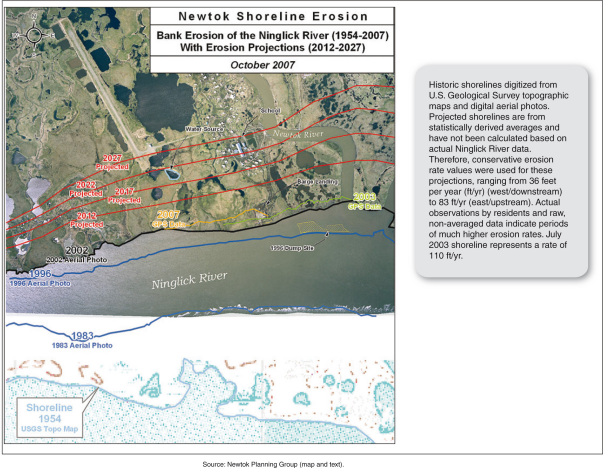Relocation in Alaska:
A brief history of how climate change is affecting native villages
With an area of around 1.6 million km2, Alaska is the US´ largest state. Its coastline stretches over around 53 thousand km, most of which is inhabited by indigenous or native populations (Marino, 2010). They represent 13 per cent of the state´s inhabitants (USGOA, 2009) and group themselves in 213 villages, comprising approx. 109,000 inhabitants (by July 2011) (U.S. Census Bureau, 2014).
The communities’ population size varies over the year due to seasonal migration for hunting, fishing and harvesting of seasonal fruits (Hamilton et al., 2012). Only those mobility and techniques allow the people to cope with the extreme natural conditions in the US´ most northern state (McNeeley, 2012). The native people used to be nomads before the government forced them to settle down in permanent villages at the beginning of the 20th century. This made them dependent on subsidies and infrastructures provided there (e.g. health centers and schools) and consequently on the residence at a fixed location. Traditional nomad knowledge and livelihoods became inferior instead (Marino, 2010; Bronen, R. & Chapin, F., 2013).
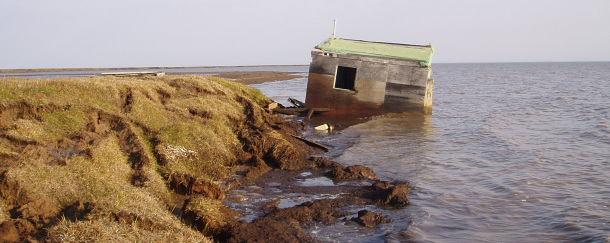
Coastline erosion in Alaska © USGS / Benjamin Jones
Regarding climate change, Alaska constitutes one of the world regions, which are most affected, with weather conditions becoming more variable and less predictable. The interior of the land is described as “one of the fastest warming places on Earth” (McNeeley, 2012; p.835). A general increase of the mean temperatures (between two and three degrees Celsius) is already observed, resulting in longer and milder winters that feature less extreme cold temperatures (ACIA, 2005). Increasing retreat of sea ice, melting of permafrost (the latter leading to moving subsoil and erosion), changes in river flow patterns, increasing windiness and coastal flooding have been identified as climate change impacts in Alaska. The latter two are most frequent, affecting 86 per cent of the state´s villages (USGOA, 2009). Impacts from climate change also endanger traditional lifestyle and the food security of native communities (ACIA, 2004). Alaska’s indigenous people have perceived that “climate change is occurring faster than people can adapt" (ACIA Report 2005).
Since 1978, 228 coastal flooding events have been reported, which led to disaster declarations in 119 communities. More recently, an increased frequency of floods could be observed: around 40 per cent of all events since 1978 occurred between 2000 and 2008. The worst year in record has been the year 2005 with 23 flooding events. The U.S. Government Accountability Office (USGAO) identified 31 of the villages as “being in imminent danger due to climate change-induced erosion and flooding” (USGAO, 2009).
Relocation has been identified as major adaptation strategy in order to protect lives and infrastructure against climate change impacts (Bronen, R. & Chapin, F., 2013a). Of the 31 endangered villages, at least 12, located in river and coastal areas, have decided to relocate partly or entirely and four of those are in need of immediate action: Kivalina, Newtok, Shaktoolik and Shishmaref (representing approx. 0.4 per cent of the state’s population) (USGOA, 2009). In the future, other villages will require major adjustments or relocation (Huntington et al., 2012).
According to an erosion assessment made in the year 2006, an estimated 10 to 15 years remain to those four villages, before their current location will be entirely lost due to moving subsoil. The estimated costs for the relocation of each village range from USD 80 to UDS 200 million (USGOA, 2009).
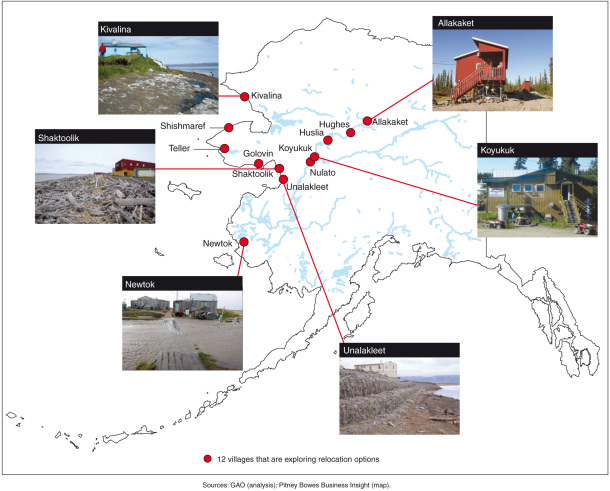
© US Government Accountability Office (GAO)
According to Bronen, R. & Chapin, F. (2013a, pp.9321), there are three important steps in a relocation process:
(i) identification of a new village site,
(ii) resident voter approval of the relocation site, and
(iii) documentation of the need to relocate and of the suitability of the new location.
Bronen and Chapin (2013b) mention some strategies that foster adaptive governance to climate change:
- Identify current climate-related risks and vulnerabilities and project their future changes.
- Adapt to those current climate extremes that are projected to become more pronounced.
- Identify limits to current adaptation options and explore viable alternatives.
- Integrate ecological integrity and societal well-being.
- Integrate climate-change adaptation with other societal goals.
- Bridge among organizations to facilitate communication, collaboration, and learning.
- Seek interdisciplinary, multi-sector engagement that fosters local leadership and engages local governing institutions in identifying potential solutions.
That process seems to be straight forward, but once a new site for relocation has been identified, the next steps to follow are not clear according to the legal framework. By 2013, only the village Newtok had begun its relocation process (Bronen, R. & Chapin, F., 2013a).
Other than in the case of extreme events, relocation of communities affected by climate change induced hazards faces the difficulty of non-existence of an institutional framework addressing its issue. For example, according to U.S legislation related to relief and emergency, drought is the only slow-onset phenomena that can be included in order to be declared a “disaster”, in which case the Federal Emergency Management Agency (FEMA) can operate. Coastal erosion and flooding, which affects Alaska’s native villages are not included in FEMA's mandate (Bronen, R. & Chapin, F., 2013a).
Nowadays, in the U.S., funding for pre-disaster mitigation through federal agencies is available, but Alaska´s native villages may be ineligible due to the large amount of investment needed to relocate remote and relatively small populations. Another problem that villages are facing is that, as they have decided to relocate, they cannot access to funding for repairing and maintaining storm-damaged infrastructure in their current locations (Bronen, R. & Chapin, F., 2013a). So far, some investments in infrastructure for the control of coastal erosion and for flood protection have been made, but storms continue to damage public infrastructure and homes (Bronen, R. & Chapin, F., 2013a; USGAO, 2009).
Because Alaska native villages were forced to become permanent settlers, part of their traditional knowledge got lost, making them unable to return to their original livelihoods independent of settlement and subsidy issues (Marino, 2010; Huntington et al., 2012; Bronen, R. & Chapin, F., 2013a).
The Shishmaref Village Case
The case of the Shishmaref village can be used as a depicting example, highlighting the impacts of climate change and the resulting difficulties for native villages.
The settlement is located on Sarichef Island in Western Alaska. Its inhabitants belong to the Kigiqitamiut community, who are part of the Inupiaq nations. In earlier times and following the natural conditions and seasonal changes, the inhabitants of the island have been seasonally sedentary, spending summers and falls inland and winters and springs at the coast (Marino, 2010).
The Sarichef Island always has been vulnerable to storms and erosion, but those phenomena haven’t been a problem as during fall and summer time the coast was not inhabited. In the last decades it suffered stronger from flooding and erosion, caused by anthropogenic climate change. Nowadays, especially the storms in the fall season are problematic for the island´s inhabitants as they produce massive wave pressure and soil erosion. (Marino, 2010).
The island’s first permanent infrastructures were constructed at the beginning of the 20th century as a way to force the people to settle down, without taking into account the knowledge and livelihoods of the locals. The construction of the school has been a key factor in changing the sedentary seasonal character of the population, making the Kigiqitamiut people permanent residents. This made them vulnerable to the fall storms (Marino, 2010) and dependent on federal and state subsidies in order to cover their needs (Huntington et al., 2012).
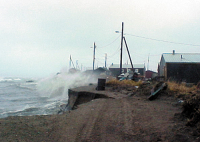
© NOAA / Nome Nugget Newspaper.
In recent decades, several major flood and storms events that impacted on the island have been registered (in 1973, 1974, 1988 and 1997). All of them feature fast erosion processes (up to 40 meters), damage of seawalls and relocation of houses, which also led to the declaration of disaster (Marino, 2010). In order to mitigate the impacts of storms and floods on the area, investment of about USD 16 million for shoreline protection have been made over the past decades (Bronen, R. & Chapin, F., 2013a).
However, due to its vulnerability, the possibility of relocation of the village as the only adaptation strategy has been on the table since the 1970s, but without any clear outcome up to date. The estimated costs of Shishmaref’s relocation are USD 180 million. In 2002, the inhabitants voted for the relocation of the entire village due to the vulnerability at its current location. A local committee in charge of the process of selecting a new village location has been created. In 2004, the community selected a new location, but due to the presence of ice-rich permafrost the site was discarded. Literature shows that after many years and various efforts little progress on the relocation process has been achieved, mainly due to high relocation costs, lack of political commitment and institutional changes (Marino, 2010; Bronen, R. & Chapin, F., 2013a).
If relocation of the entire village does not occur, the population would be forced to migrate to more urban environments like Anchorage, which would affect their entire livelihoods (Marino, 2010).
A factor that further increases the vulnerability of the Shishmaref Village, as well as other villages in the region, is its dependence on federal and state subsidies to develop their activities due to the minimal local revenue (Huntington et at, 2012).
Finally, the Shishmaref case shows that disparity in political economy and decision-making power creates vulnerability to anthropogenic climate change. In accordance with Huntington et al (2012, pp.67), the village relocation process in Alaska “illustrates limitations in political will to spend money responding to impacts of climate change”.
- Arctic Climate Impact Assessment (ACIA) (2004) Impacts of a Warming Arctic. Cambridge, Cambridge University Press.
- ACIA Report (2005), page 92
- Bronen, R. & Chapin, F. S. (2013a) Adaptive governance and institutional strategies for climate-induced community relocations in Alaska. Proceedings of the National Academy of Sciences of the United States of America. 110 (23), p. 9320-25.
- Bronen, R. & Chapin, F. S. (2013b), Supporting Information
- Hamilton, L., White, D., Lammers, R. & Myerchin, G. (2012) Population, climate, and electricity use in the Arctic integrated analysis of Alaska community data. Population & Environment. 33, p. 269-283.
- Huntington, H., Goodstein, E. & Euskirchen, E. (2012) Towards a tipping point in responding to change: rising costs, fewer options for arctic and global societies. AMBIO: A Journal of the Human Environment. 41, p. 66-74.
- Marino, E. (2010) Environmental migration, climate change and social theory: a study in disparity and movement. ICARUS workshop on Climate Vulnerability and Adaptation, 2010, University of Illinois.
- McNeeley, S. (2012) Examining barriers and opportunities for sustainable adaptation to climate change in Interior Alaska. Climatic Change. 111, p. 835-857.
- United States General Accounting Office (USGOA) (2009) Alaska Native Villages: Limited Progress Has Been Made on Relocating Villages Threatened by Flooding and Erosion. Report to Congressional Committees.
- United States Census Bureau (U.S. Census Bureau) (2014) State & County QuickFacts, People QuickFacts.
- U.S. Census Guide: How to get the most out of census.gov

